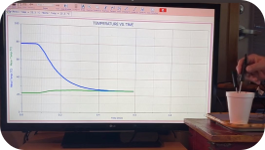Estrategia CMID adaptada a la virtualidad para estudiar el equilibrio térmico en formación inicial docente

- PDF (Español (España)) 639
- EPUB (Español (España)) 49
- VISOR (Español (España))
- MÓVIL (Español (España))
- XML (Español (España)) 43
DOI
https://doi.org/10.25267/Rev_Eureka_ensen_divulg_cienc.2023.v20.i3.3201Info
Abstract
The use of the Interactive Lecture Demonstrations strategy adapted to virtual session to a fifth-year student teachers’ class is described. The results are analyzed under the approach oriented to the student teachers' level of understanding of the concept of thermal equilibrium and to their pedagogical knowledge. At the beginning, 83% of the students had inadequate previous ideas about how the temperature of two objects in thermal contact, both with different mass and different initial temperatures, change over time. After applying the strategy, Hake's factor was determined to know the learning gain. Its value was 0,429, which is considered a medium gain. The student teachers’ exit ticket showed the high valuation given by them to the ILD strategy. Student teachers highlighted the importance of social learning and the process of their own physics concept reconstruction through a metacognition exercise.
Downloads
How to Cite
License
Copyright (c) 2023 Rolando Adán Díaz-Delgado, María José Carreño-Matus

This work is licensed under a Creative Commons Attribution-NonCommercial 4.0 International License.
Require authors to agree to Copyright Notice as part of the submission process. This allow the / o authors / is non-commercial use of the work, including the right to place it in an open access archive. In addition, Creative Commons is available on flexible copyright licenses (Creative Commons).

Reconocimiento-NoComercial
CC BY-NC
References
Buchanan, S., Harlan, M. A., Bruce, C. S. y Edwards, S. L. (2016). Inquiry based learning models, information literacy, and student engagement: A literature review. School Libraries Worldwide, 22(2), 23-39.
Bybee, R. W., Taylor, J. A., Gardner, A., Van Scotter, P., Carlson, J., Westbrook, A. y Landes, N. (2006). The BSCS 5E instructional model: Origins, effectiveness, and applications. http://www.bscs.org/pdf/5EFull Report. pdf
Carlton, K. (2000). Teaching about heat and temperature. Physics Education, 35(2), 101.
Díaz-Delgado, R. A. y Maringer-Duran, D. A. (2021). La enseñanza del concepto de fuerza: algunas reflexiones. Lat. Am. J. Sci. Educ, 8, 12006.
Díaz-Delgado, R. A., Menéndez-Proupin, E., Carreño, M. J., Díaz, R. y Lizana, K. (2020). Experiencia de clases activas en un curso de introducción a la mecánica en el ámbito universitario [Libro de Actas]. VI Encuentro Nacional de Didáctica de la Física. ISBN 978-956-330-073-4. Chile. https://www.ucentral.cl/ucentral/site/docs/20210503/20210503172433/libro_de_actas_enfi_2020___isbn_978_956_330_073_4.pdf
Gunstone, R. y White, R. (1990). Understanding of gravity. Science education. Vol. 65, Nº 3, pp. 291-299.
Hake, R. R. (1998). Interactive-engagement versus traditional methods: A six-thousand-student survey of mechanics test data for introductory physics courses. American journal of Physics, 66(1), 64-74.
Kurniawan, Y., Suhandi, A. y Hasanah, L. (2016). The influence of implementation of interactive lecture demonstrations (ILD) conceptual change oriented toward the decreasing of the quantity students that misconception on the Newton’s first law. In AIP Conference Proceedings (Vol. 1708, No. 1, p. 070007). AIP Publishing LLC. https://doi.org/10.1063/1.4941180
Laws, P. W. y Thornton, R. K. (1993). FIPSE Interactive Physics Project (October 1989-August 1993). Final Report. https://eric.ed.gov/?id=ED461492.
Laws, P., Sokoloff, D. y Thornton, R. (1999). Promoting Active Learning Using the Results of Physics Education Research. UniServe Science News, Vol. 13.
http://sydney.edu.au/science/uniserve_science/newsletter/vol13/sokoloff.html
Milner-Bolotin, M., Kotlicki, A. y Rieger, G. (2007). Can students learn from lecture demonstrations. J Coll Sci Teach, 36, 45-49.
Prince, M. (2004). Does active learning work? A review of the research. Journal of engineering education, 93(3), 223-231.
Redish, E. F., Saul, J. M. y Steinberg, R. N. (1997). On the effectiveness of active-engagement microcomputer-based laboratories. American journal of physics, 65(1), 45-54.
Sanmartí, N. (1997). Enseñar y aprender ciencias: algunas reflexiones. http://www.pedagogiapucv.cl/wp-content/uploads/2017/07/Ense%C3%B1anza-de-las-Ciencias-Neus-Sanmart%C3%AD.pdf
Sharma, M. D., Johnston, I. D., Johnston, H., Varvell, K., Robertson, G., Hopkins, A., Stewart, C., Cooper, I. y Thornton, R. (2010). Use of interactive lecture demonstrations: A ten-year study. Phys. Rev. S T Phys. Educ. Res. 6. 020119. https://doi.org/10.1103/PhysRevSTPER.6.020119
Sokoloff D.R. y Thornton R.K. (1997). Using interactive lecture demonstrations to create an active learning environment, The Physics Teacher, 35, 340- 347.
Sokoloff, D. y Thornton, R. (2017). Active Learning with Interactive Lecture Demonstrations. New Faculty Workshop, American Center for Physics, June 13, 2017.
https://www.aapt.org/Conferences/newfaculty/upload/Thornton-Sokoloff-Interactive-Demos.pdf
Sokoloff, D. (2021). Home Adapted ILDs. https://pages.uoregon.edu/sokoloff/IntroHTDemo2.mp4
Tanahoung, C., Chitaree, R., Soankwan, C., Sharma, M. D. y Johnston, I. D. (2009). The effect of interactive lecture demonstrations on students’ understanding of heat and temperature: a study from Thailand. Research in Science & Technological Education, 27(1), 61-74.
Taufiq, M., Suhandi, A. y Liliawati, W. (2017). Effect of science magic applied in interactive lecture demonstrations on conceptual understanding. In AIP Conference Proceedings (Vol. 1868, No. 1, p. 070007). AIP Publishing LLC.
Thornton, R.K. y Sokoloff, D.R. (1990). Learning motion concepts using real-time, microcomputer-based laboratory tools. Am. J. Phys. 58, 858-867.
Thornton, R. K. (1996). Using large-scale classroom research to study student conceptual learning in mechanics and to develop new approaches to learning. In Microcomputer–Based Labs: Educational Research and Standards (pp. 89-114). Springer. Heidelberg.
Thornton, R. K. (1997). Learning physics concepts in the introductory course: microcomputer-based labs and interactive lecture demonstrations. In Proc Conf on Intro Physics Course (pp. 69-86).
Zimrot, R. y Ashkenazi G. (2007), Interactive lecture demonstrations: a tool for exploring and enhancing conceptual change, Chemistry Education Research and Practice, 8, 197-211.






